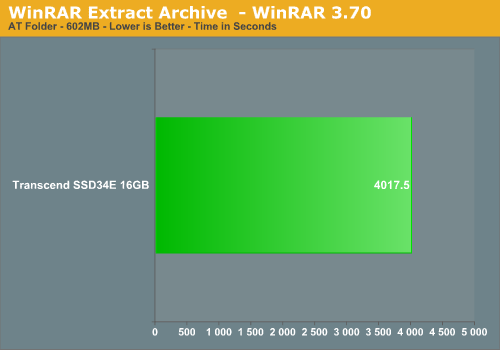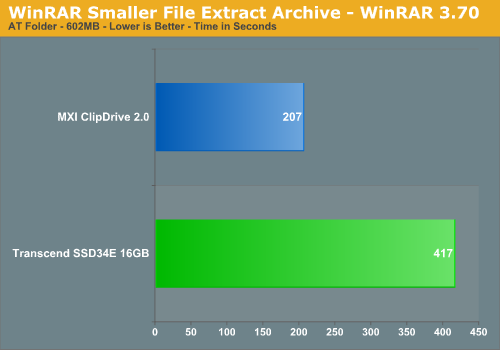Transcend TS16GSSD34E: SSD ExpressCard for those on the Go...
by Dave Robinet on October 25, 2007 12:15 AM EST- Posted in
- Storage
WinRAR 3.70
The first of our WinRAR tests measures the time it takes to compress our test folder that contains 444 files, 10 folders, and 602MB of data from our source WD Raptor drive to the target drive. In order to preclude other components (ie. the CPU) from being a factor in this test, WinRAR was set to "store" - this mode offers no actual file compression, but instead simply puts all of our test files into a single RAR archive. The resulting benchmark therefore highlights the write performance of the device in question.
We then extract the archive to a different location on the same drive, giving a benchmark which shows not only the read and write performance, but is also influenced by the seek times of the devices, since the drive must continuously move from position to position.
WinRAR Create/Extract Archive Test


The SSD34E performs the store operation in 2 minutes and 59 seconds - not only is this far behind the Samsung T166 drive at 10.06 seconds, but even the fairly generic MXI ClipDrive used for USB 2.0 comparison turns in a substantially faster performance. Clearly, this is a disappointing result for the SSD34E.
The archive extraction portion of the benchmark truly makes the SSD drive look awful. It took over 22 times as long to perform the "extract" operation when compared to our Samsung T-166 at 10.15 seconds, which is an absolutely astonishing figure.
Since our standard test folder wouldn't fit on our smaller MXI drive, we ran a smaller 100mb extract on it. We found that this smaller operation took 12 times as long on the MXI drive. Surprised at the results, we ran this same 100mb archive on the Transcend ExpressCard, and found that the 12:1 ratio did indeed carry over to the Transcend device:
WinRAR Smaller File Create/Extract Archive Test


While it is somewhat reassuring that the Transcend ExpressCard isn't bested in terms of the increased extract time ratio, the reality is that it is still trounced soundly by the fairly standard MSI ClipDrive.
The first of our WinRAR tests measures the time it takes to compress our test folder that contains 444 files, 10 folders, and 602MB of data from our source WD Raptor drive to the target drive. In order to preclude other components (ie. the CPU) from being a factor in this test, WinRAR was set to "store" - this mode offers no actual file compression, but instead simply puts all of our test files into a single RAR archive. The resulting benchmark therefore highlights the write performance of the device in question.
We then extract the archive to a different location on the same drive, giving a benchmark which shows not only the read and write performance, but is also influenced by the seek times of the devices, since the drive must continuously move from position to position.
WinRAR Create/Extract Archive Test


The SSD34E performs the store operation in 2 minutes and 59 seconds - not only is this far behind the Samsung T166 drive at 10.06 seconds, but even the fairly generic MXI ClipDrive used for USB 2.0 comparison turns in a substantially faster performance. Clearly, this is a disappointing result for the SSD34E.
The archive extraction portion of the benchmark truly makes the SSD drive look awful. It took over 22 times as long to perform the "extract" operation when compared to our Samsung T-166 at 10.15 seconds, which is an absolutely astonishing figure.
Since our standard test folder wouldn't fit on our smaller MXI drive, we ran a smaller 100mb extract on it. We found that this smaller operation took 12 times as long on the MXI drive. Surprised at the results, we ran this same 100mb archive on the Transcend ExpressCard, and found that the 12:1 ratio did indeed carry over to the Transcend device:
WinRAR Smaller File Create/Extract Archive Test


While it is somewhat reassuring that the Transcend ExpressCard isn't bested in terms of the increased extract time ratio, the reality is that it is still trounced soundly by the fairly standard MSI ClipDrive.










10 Comments
View All Comments
strikeback03 - Wednesday, October 31, 2007 - link
Any chance of comparing one of these to a 16GB Corsair FlashVoyager? The Corsair would seem to be more useful unless you always leave the card in a laptop, the Corsair is less expensive, and IIRC quotes higher speeds as well.Also the Extract Archive chart on page 5 - is that really supposed to say 4000 seconds?
JoeBleed - Monday, November 12, 2007 - link
What file system format was used on this drive and the regular USB memory stick?The reason i ask is that i find NTFS under 2k and XP to perform much better than FAT 32.
darkfoon - Saturday, October 27, 2007 - link
On page 5 of the article, at the bottom, the ClipDrive is called the "MSI ClipDrive" however, throughout the rest of the article its been called the MXI ClipDrive.I assume that MSI is a typo, however I've never heard of the MXI brand, so I'm a little confused, I suppose.
ksherman - Thursday, October 25, 2007 - link
This is an ExpressCard SSD, but uses the USB standard to communicate with the computer (even when in the ExCard slot)?! That seems odd, wouldn't the express slot provide faster performance?Dave Robinet - Friday, October 26, 2007 - link
Expresscard uses either USB or SATA as means for communication (page 1 diagram shows that a bit better), so not really - if they'd chosen SATA as the communication method, then it would have better throughput, though.Regardless, the card doesn't approach the maximum transfer rate of the USB bus, so it's a non-issue.
Thanks for reading!
defman - Thursday, October 25, 2007 - link
Some info on how this would perform as a Windows Readyboost device would be nice....dvinnen - Thursday, October 25, 2007 - link
I was thinking it would make for a good ReadyBoost device for the laptop as well. Some info on how it performs there would be nice.Also, is it USB2 that is holding the speed back? If so they really should of done a dual bus, cardbus for when in a laptop, usb for when using the adapter...
Dave Robinet - Friday, October 26, 2007 - link
No, USB isn't holding the speed back at all. You've got loads more room in the USB2 bus for additional performance from the card - it just isn't there.As for ReadyBoost... given the performance of the card, it's doubtful that it would have made an improvement worth spending the additional money on. Good suggestion, though - if we do another Expresscard device in the future, I'll make sure to include it.
Thanks for reading!
-dave
Weiman - Thursday, October 25, 2007 - link
My thoughts exactly.yyrkoon - Thursday, October 25, 2007 - link
One one hand you have the ability to have more storage with potential for less power draw, fast access times, and the ability to just connect it and not have an external power source to worry about.On the other hand, you had a VERY slow product, that barely outperform the average USB v2.0 device, with limited amount of storage potential.
Price does not look terrible though, but I would imagine you could just as easily buy a Corsair 16GB thumb drive for the same price, and not worry about one of these . . . although if this were bootable(did not see it in the article).